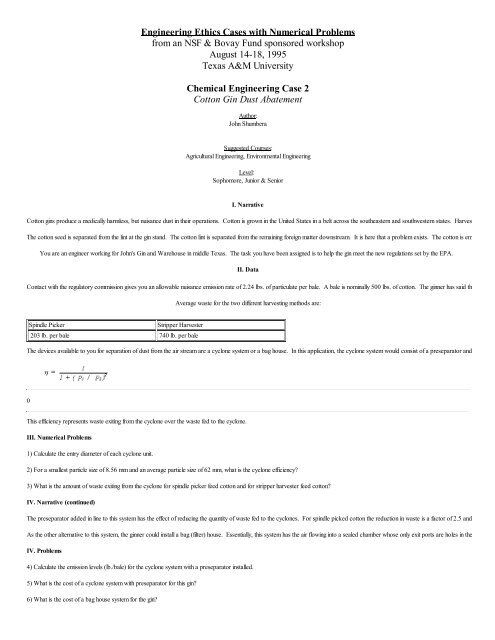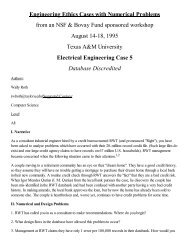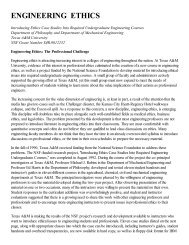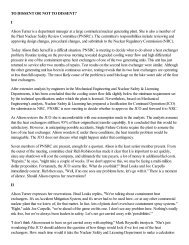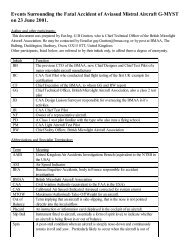Cotton Gin Dust Abatement - Engineering Ethics - Texas A&M ...
Cotton Gin Dust Abatement - Engineering Ethics - Texas A&M ...
Cotton Gin Dust Abatement - Engineering Ethics - Texas A&M ...
Create successful ePaper yourself
Turn your PDF publications into a flip-book with our unique Google optimized e-Paper software.
<strong>Engineering</strong> <strong>Ethics</strong> Cases with Numerical Problems<br />
from an NSF & Bovay Fund sponsored workshop<br />
August 14-18, 1995<br />
<strong>Texas</strong> A&M University<br />
Chemical <strong>Engineering</strong> Case 2<br />
<strong>Cotton</strong> <strong>Gin</strong> <strong>Dust</strong> <strong>Abatement</strong><br />
Author:<br />
John Shumbera<br />
Suggested Courses:<br />
Agricultural <strong>Engineering</strong>, Environmental <strong>Engineering</strong><br />
Level:<br />
Sophomore, Junior & Senior<br />
I. Narrative<br />
<strong>Cotton</strong> gins produce a medically harmless, but nuisance dust in their operations. <strong>Cotton</strong> is grown in the United States in a belt across the southeastern and southwestern states. Harvesting of this<br />
The cotton seed is separated from the lint at the gin stand. The cotton lint is separated from the remaining foreign matter downstream. It is here that a problem exists. The cotton is emptied into<br />
You are an engineer working for John's <strong>Gin</strong> and Warehouse in middle <strong>Texas</strong>. The task you have been assigned is to help the gin meet the new regulations set by the EPA.<br />
II. Data<br />
Contact with the regulatory commission gives you an allowable nuisance emission rate of 2.24 lbs. of particulate per bale. A bale is nominally 500 lbs. of cotton. The ginner has said that the gin<br />
Average waste for the two different harvesting methods are:<br />
The devices available to you for separation of dust from the air stream are a cyclone system or a bag house. In this application, the cyclone system would consist of a preseparator and 14 cyclon<br />
Spindle Picker<br />
Stripper Harvester<br />
203 lb. per bale 740 lb. per bale<br />
0<br />
This efficiency represents waste exiting from the cyclone over the waste fed to the cyclone.<br />
III. Numerical Problems<br />
1) Calculate the entry diameter of each cyclone unit.<br />
2) For a smallest particle size of 8.56 mm and an average particle size of 62 mm, what is the cyclone efficiency?<br />
3) What is the amount of waste exiting from the cyclone for spindle picker feed cotton and for stripper harvester feed cotton?<br />
IV. Narrative (continued)<br />
The preseparator added in line to this system has the effect of reducing the quantity of waste fed to the cyclones. For spindle picked cotton the reduction in waste is a factor of 2.5 and for stripp<br />
As the other alternative to this system, the ginner could install a bag (filter) house. Essentially, this system has the air flowing into a sealed chamber whose only exit ports are holes in the floor from<br />
IV. Problems<br />
4) Calculate the emission levels (lb./bale) for the cyclone system with a preseparator installed.<br />
5) What is the cost of a cyclone system with preseparator for this gin?<br />
6) What is the cost of a bag house system for the gin?
V.Narrative (continued)<br />
Discussion with the gin owner reveals that there is only a small financial margin in a ginning operation. Therefore, it is very important that costs for the new equipment be kept to a minimum. A gi<br />
The engineer knows that any nuisance emission causes problems for the gin's neighbors. His situation is that he has his employer to consider with the need to be as cost effective in capital expend<br />
VI. Ethical Problems<br />
7) Which design should you recommend to the gin owner?<br />
8) Where do your primary responsibilities lie as an engineer?<br />
9) If you were told that continuing complaints to the EPA by persons affected by the nuisance dust was already bringing hearings on a new stricter standard and that a new standard will likely foll<br />
VII. Solutions<br />
1)The total volume flow rate of air, Q, is 100,000 cfm. The volume per cyclone is 100,000 / 14 = 7143 cfm. Assuming uniform velocity distribution across the entry diameter, the entry cross se<br />
0<br />
Thus, A = 7143 / 3400 = 2.1 ft 2 , the diameter is:<br />
0<br />
2) Solving the equation given for efficiency, P 1 / P 2 = 8.56 / 62 = 0.138. This squared is 0.019. The efficiency is 1 / 1.019 = 98%.<br />
3) Cyclone efficiency yields 2% waste exiting from the system. The waste values per bale for the two harvesting methods is:<br />
0.02 X 203 lb. / bale = 4.06 lb. / bale (spindle)<br />
0.02 X 740 lb. / bale = 14.8 lb. /bale ( stripper)<br />
4) Reducing in quantity of dust fed reduces the quantity of dust exiting the system. The assumption is that the cyclone efficiency is constant over total dust volume. This is generally not true, at lea<br />
0<br />
0<br />
5) The preseparator component of cost is $0.30, and the cyclone component is $1.00 per cfm of air processed. The total cfm of process air is 100,000 cfm. The total cost is $130,000.<br />
6) The bag house system costs $8.00 per cfm giving a total cost of $800,000 for the installation.<br />
7) The gin owner may not be able to stay in business and purchase the bag house. Nevertheless, the bag house is the clear choice when the ethical consideration of the effect of dust on the gin's<br />
8) Your responsibilities are divided between what you owe to your employer and what you owe to the public and its well being. Your task when facing ethical choices is to work diligently to see<br />
9) The engineer will not make the decision to purchase a bag house. That is done by the gin owner. Nevertheless, the engineer has the responsibility to press the case strongly for the solution wh<br />
VIII. Additional Ethical Problems and Solutions<br />
1. List 2 conflicting obligations faced by the engineer.<br />
Hint: Refer to your code of ethics.<br />
While you have an obligation to protect the health and welfare of the public, engineers also have an obligation to be loyal and faithful agents to their employers. Here the issue revolves arou
2. Based on your previous calculations and the data provided, show how the two options (the bag house and the cyclone) meet each obligation.<br />
Both designs meet the obligation to protect the public. However, the bag filter seems to be a better system than a cyclone by itself. But, can be seen from the calculations, adding a presepa<br />
Both designs fail to meet the obligation to the employer. The bag house is clearly to expensive for the ginner to purchase. The cyclone design would be the best choice to recommend. It is<br />
3. A creative-middle-way solution is an alternative solution to a problem with conflicting issues. This solution usually will be able to meet both obligations in conflict better that the original s<br />
Here the students can come up with several ideas, including newer technology and designs. The obvious creative-middle-way solution would be to use the cyclone design with more than on<br />
4. Of the three choices the engineer has (the bag house, cyclone, and the creative-middle-way solution) which one is the best? Why?<br />
Here the creative-middle-way solution should be the best choice, although it doesn't have to be. This choice will better meet the conflicting issues in the case. Engineers should strive to me


